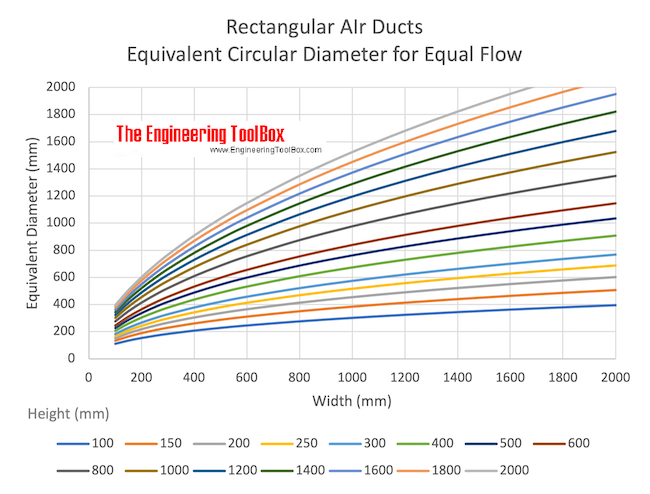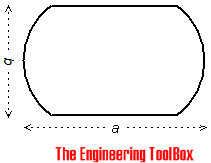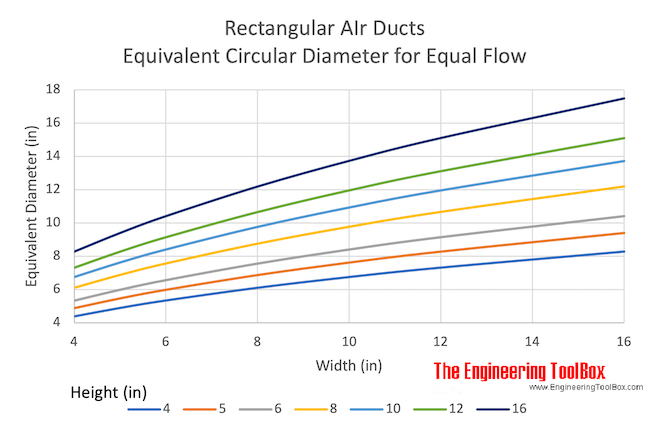Fluid Flow - Equivalent Diameter
Convert rectangular and oval duct geometry to a equivalent circular diameter - online calculator with imperial and SI-units.
The equivalent diameter is the diameter of a circular duct or pipe that for equal flow gives the same pressure loss or resistance as an equivalent rectangular duct or pipe. A round shape results in lower pressure drops and less fan horsepower to move the air and, consequently, smaller equipment.

The equivalent diameter of a rectangular tube or duct can be calculated as (Huebscher)
de = 1.30 (a b)0.625 / (a + b)0.25 (1)
where
de = equivalent diameter (mm, inches)
a= length of major or minor side (mm, inches)
b= length of minor or major side (mm, inches)
- Hydraulic diameter - the "characteristic length" used to calculate the dimensionless Reynolds Number
Example - Equivalent Diameter
The equivalent diameter of a 300 mm x 500 mm rectangular duct can be calculated as
de = 1.30 ((300 mm) (500 mm))0.625 / ((300 mm) + (500 mm))0.25
= 420 mm
Rectangular to Equivalent Circular Duct Calculator
The calculator below is based on formula (1). The formula is generic and any unit can be used.
Equivalent diameters for some common mm rectangular duct dimensions:
For full table with larger dimensions - rotate the screen!
| Circular equivalent diameter - de (mm) | |||||||||||||||
|---|---|---|---|---|---|---|---|---|---|---|---|---|---|---|---|
| Duct side - a - (mm) | Duct side - b (mm) | ||||||||||||||
| 100 | 150 | 200 | 250 | 300 | 400 | 500 | 600 | 800 | 1000 | 1200 | 1400 | 1600 | 1800 | 2000 | |
| 100 | 109 | 133 | 152 | 168 | 183 | 207 | 227 | ||||||||
| 150 | 133 | 164 | 189 | 210 | 229 | 261 | 287 | 310 | |||||||
| 200 | 152 | 189 | 219 | 244 | 266 | 305 | 337 | 365 | |||||||
| 250 | 168 | 210 | 246 | 273 | 299 | 343 | 381 | 414 | 470 | ||||||
| 300 | 183 | 229 | 266 | 299 | 328 | 378 | 420 | 457 | 520 | 574 | |||||
| 400 | 207 | 260 | 305 | 343 | 378 | 437 | 488 | 531 | 609 | 674 | 731 | ||||
| 500 | 227 | 287 | 337 | 381 | 420 | 488 | 547 | 598 | 687 | 762 | 827 | 886 | |||
| 600 | 310 | 365 | 414 | 457 | 531 | 598 | 656 | 755 | 840 | 914 | 980 | 1041 | |||
| 800 | 414 | 470 | 520 | 609 | 687 | 755 | 875 | 976 | 1066 | 1146 | 1219 | 1286 | |||
| 1000 | 517 | 574 | 674 | 762 | 840 | 976 | 1093 | 1196 | 1289 | 1373 | 1451 | 1523 | |||
| 1200 | 620 | 731 | 827 | 914 | 1066 | 1196 | 1312 | 1416 | 1511 | 1598 | 1680 | ||||
| 1400 | 781 | 886 | 980 | 1146 | 1289 | 1416 | 1530 | 1635 | 1732 | 1822 | |||||
| 1600 | 939 | 1041 | 1219 | 1373 | 1511 | 1635 | 1749 | 1854 | 1952 | ||||||
| 1800 | 1096 | 1286 | 1451 | 1598 | 1732 | 1854 | 1968 | 2073 | |||||||
| 2000 | 1523 | 1680 | 1822 | 1952 | 2073 | 2186 | |||||||||

print equivalent diameter diagram!
Equivalent diameters of some common inches rectangular ducts:
For full table - rotate the screen!
| Circular equivalent diameter (inches) | |||||||
|---|---|---|---|---|---|---|---|
| Length - b - (inches) | Length - a - (inches) | ||||||
| 4 | 5 | 6 | 8 | 10 | 12 | 16 | |
| 4 | 4.4 | 4.9 | 5.3 | 6.1 | |||
| 5 | 4.9 | 5.5 | 6 | 6.9 | 7.6 | ||
| 6 | 5.3 | 6 | 6.6 | 7.6 | 8.4 | 9.1 | |
| 8 | 6.1 | 6.9 | 7.6 | 8.6 | 9.8 | 10.7 | 12.2 |
| 10 | 7.6 | 8.4 | 9.8 | 10.9 | 12 | 13.7 | |
| 12 | 9.1 | 10.7 | 12 | 13.1 | 15.1 | ||
| 16 | 12.2 | 13.7 | 15.1 | 17.5 | |||
print equivalent diameter diagram!
Oval Equivalent Diameter (Ellipse)
Flat oval ducts have smaller height requirements than round ducts and retain most of the advantages of the round ducts. Fittings for flat oval ducts are difficult to fabricate or modify in the field.
The equivalent diameter of a oval duct or tube (ellipse) can be calculated as (Heyt & Diaz)
de = 1.55 A0.625 / P0.25 (2)
where
A = cross-sectional area oval duct (m2, in2)
P = perimeter oval duct (m, inches)

The cross-sectional area of an oval duct can be expressed as
A = π a b / 4
where
a = major dimension of the flat oval duct (m, in)
b = minor dimension of the flat oval duct (m, in)
The perimeter of an oval duct (ellipse) can be approximated to
P ≈ 2 π (1/2 ((a / 2)2 + (b / 2)2))1/2 (2b)
Oblong Ducts

Equivalent diameters of oblong ducts or pipes can be expressed as
de = 1.55 (π b2/ 4 + a b - b2)0.625 / (π b + 2 a - 2 b)0.25 (3)
Hydraulic Diameter
Note! - equivalent diameter is not the same as hydraulic diameter. The hydraulic diameter express the rate between the area section of the duct or tube, and the wetted perimeter of the duct or tube. Hydraulic diameter is used to determine if the flow is laminar or turbulent and to calculate the pressure loss.




